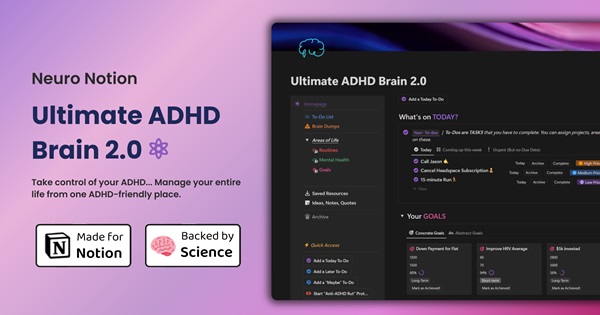Ultimate ADHD Brain Template 2.0 – All-in-one ADHD Life Manager Notion Template
$99.00 Original price was: $99.00.$12.00Current price is: $12.00.
- Delivery: You Will Receive A Receipt With Download Link Through Email.
- If you need more proof ofcourse, feel free to chat with me!

Sales Page: https://neuronotionn.gumroad.com/l/ultimateadhdbrain
Delivery Time: Instant DownloadDescription
Table of Contents
ToggleNotion ADHD: Is Neuro Notion’s Template the Ultimate Solution? Are you struggling to manage life with ADHD using conventional tools? The Neuro Notion Ultimate ADHD Brain Template 2.0 promises to be a game-changer. This review dives deep into its features, benefits, and potential drawbacks, helping you decide if this Notion template is the key to unlocking your productivity.
Notion ADHD
The intersection of Notion and ADHD has become a hot topic in recent years, and for good reason. Individuals with ADHD often face unique challenges when it comes to organization, focus, and task management. Traditional productivity tools, designed with a neurotypical brain in mind, often fall short, leaving individuals feeling overwhelmed, frustrated, and even more disorganized.
This is where the promise of a customized Notion template, specifically designed for the ADHD brain, becomes incredibly appealing. The ability to tailor a digital workspace to accommodate specific needs, learning styles, and cognitive preferences offers a potential lifeline for those navigating the complexities of ADHD daily.
Why Traditional Productivity Tools Often Fail
Why do standard planners, to-do lists, and project management software frequently fail those with ADHD? The answer lies in the fundamental differences in neurological functioning. Individuals with ADHD often struggle with executive function, which encompasses skills like planning, organization, time management, and impulse control. Traditional tools often demand a linear, structured approach that clashes with the more dynamic and often scattered thought processes characteristic of ADHD. The overwhelming nature of complex interfaces and rigid structures can trigger anxiety and avoidance, ultimately leading to abandonment of the system altogether. Furthermore, the lack of visual cues, gamification elements, and built-in reminders can make it difficult to maintain consistent engagement and motivation.

Traditional tools often lack the flexibility and adaptability needed to accommodate the fluctuating attention spans and energy levels common in ADHD. A task management system that requires meticulous input and constant updating can quickly become a source of overwhelm, leading to procrastination and a sense of falling behind. Similarly, rigid calendars and scheduling tools can feel restrictive and stifling, especially for individuals who thrive on spontaneity and flexibility. The key is to find a system that works with the ADHD brain, rather than against it.
Another critical challenge is the difficulty in task initiation. Many individuals with ADHD struggle to start tasks, even those they find interesting or important. This can be due to various factors, including difficulty prioritizing, feeling overwhelmed by the scope of the task, or a lack of intrinsic motivation. Traditional productivity tools often fail to address this underlying issue, leaving individuals feeling stuck and unable to move forward. A system designed for ADHD needs to incorporate strategies to break down tasks into smaller, more manageable steps, provide visual cues and reminders to initiate action, and offer positive reinforcement to maintain momentum. Ultimately, the success of a Notion template hinges on its ability to address these core challenges and provide a scaffolding for improved organization, focus, and self-management.
The Allure of a Notion-Based Solution
Notion’s appeal as a potential solution for individuals with ADHD stems from its unparalleled flexibility and customizability. Unlike rigid, pre-defined productivity platforms, Notion allows users to build their own digital workspaces from the ground up, tailoring every aspect to their specific needs and preferences. This inherent adaptability is particularly valuable for individuals with ADHD, who often require personalized systems that cater to their unique learning styles, cognitive strengths, and attention patterns. The ability to create visual dashboards, incorporate multimedia elements, and automate repetitive tasks makes Notion a powerful tool for managing the complexities of daily life.
The visual nature of Notion is also a significant advantage. Individuals with ADHD often respond well to visual cues and stimulation. Notion allows users to create visually appealing layouts with color-coded tags, icons, and embedded images, making it easier to process information and stay engaged. The ability to organize information in a visually intuitive way can reduce mental clutter and improve focus. Furthermore, Notion’s drag-and-drop functionality and user-friendly interface make it easy to move tasks around, reorganize information, and adapt the system as needed.
Another benefit of using Notion for ADHD management is its collaborative capabilities. Notion allows users to share their workspaces with others, making it easy to collaborate on projects, share information with family members, or seek support from accountability partners. This collaborative aspect can be particularly helpful for individuals with ADHD, who may benefit from external reminders, encouragement, and assistance with task management.
Key Considerations When Choosing a Notion Template for ADHD
While Notion offers a powerful platform for building personalized productivity systems, the sheer volume of available templates and approaches can be overwhelming. When choosing a Notion template specifically designed for ADHD, it’s important to consider several key factors. Firstly, the template should be designed with the ADHD brain in mind, incorporating strategies to address common challenges such as difficulty with focus, organization, and task initiation. Look for templates that prioritize visual cues, gamification elements, and simplified workflows.
Secondly, the template should be customizable and adaptable to your individual needs and preferences. Avoid templates that are too rigid or prescriptive, as they may not be sustainable in the long run. Instead, look for templates that offer flexibility and allow you to tailor the system to your specific learning style, cognitive strengths, and daily routines. Consider whether the template includes features such as a brain dump page for capturing fleeting thoughts, a task management system with visual reminders, and a habit tracker with built-in motivation.
Finally, consider the user experience and the ease of use of the template. A complex or confusing template will likely be abandoned quickly. Look for templates that are intuitive, visually appealing, and easy to navigate. Many templates offer video tutorials or community support to help users get started and maximize their effectiveness. Ultimately, the best Notion template for ADHD is one that integrates seamlessly into your life and empowers you to manage your challenges and achieve your goals.
Ultimate brain 2.0
The Ultimate Brain 2.0, as presented by Neuro Notion, posits itself as more than just a digital planner, but as a comprehensive ecosystem designed to cater to the unique needs of the ADHD mind. It aims to be the central hub for all aspects of life management, from the mundane daily tasks to long-term goal achievement. The core premise is that traditional productivity tools are inherently flawed for those with ADHD due to their failure to acknowledge and accommodate the distinct neurological patterns associated with the condition. Ultimate Brain 2.0 aims to bridge that gap by creating a space that is both functional and engaging, fostering a sense of control and accomplishment rather than frustration and overwhelm.
Comprehensive Life Management Approach
The claim of being an “all-in-one life management system” is a bold one. The Ultimate Brain 2.0 purports to encompass everything from task management and routine tracking to mental health support, financial oversight, and even fitness and meal planning. The breadth of these features is both a strength and a potential weakness. While the comprehensive approach can be incredibly appealing for those seeking to consolidate their life management into a single, central location, it also raises concerns about complexity and potential overload.
The effectiveness of this approach hinges on the seamless integration of these various modules. If the system feels fragmented or requires excessive navigation between different sections, it could ultimately exacerbate the feelings of overwhelm that it seeks to alleviate. The key is to create a cohesive and intuitive flow that allows users to easily access and manage the information they need without feeling lost or disoriented. The promise of helping users “take back control over their ADHD” relies heavily on this holistic integration and the ability to create a sense of interconnectedness between different aspects of life.
The emphasis on managing “the boring stuff easier” is particularly relevant for individuals with ADHD, who often struggle with motivation and engagement when it comes to mundane tasks. By incorporating gamification elements, visual cues, and simplified workflows, the tool aims to make these essential activities more manageable and even enjoyable. Similarly, the promise of achieving more and stressing less hinges on the ability of the system to reduce mental clutter, improve focus, and provide a clear path towards goal achievement.
Frictionless Design and User Experience
The focus on a “frictionless” design with minimal typing and abundant interactive elements is directly targeted at addressing a key pain point for individuals with ADHD – the activation energy required to initiate tasks. By minimizing the effort required to input information, track progress, and manage the system, it aims to lower the barrier to entry and encourage consistent engagement. The use of buttons, checkboxes, and other interactive elements can also provide a more engaging and visually stimulating experience, helping to maintain focus and motivation.
However, it’s important to strike a balance between simplicity and functionality. While minimizing typing is undoubtedly beneficial, it’s crucial to ensure that the system still allows for sufficient customization and flexibility. The temptation to oversimplify or rely too heavily on pre-defined options could ultimately limit the user’s ability to tailor the system to their specific needs and preferences. The challenge lies in creating a design that is both user-friendly and adaptable, offering a seamless experience without sacrificing the power and versatility of Notion.
The emphasis on a “fun, aesthetically pleasing space” is also a valuable consideration. The environment in which we work and interact can have a significant impact on our mood, motivation, and focus. By creating a visually appealing and engaging workspace, Ultimate Brain 2.0 aims to foster a sense of positivity and enthusiasm, making it more likely that users will engage with the system consistently. The incorporation of color, imagery, and interactive elements can help to create a more stimulating and enjoyable experience, making the task of managing life feel less like a chore and more like a rewarding activity.
Customization and Automation: Tailoring to Individual Needs
The assertion that the template is “completely customisable, flexible AND AUTOMATED” is a critical selling point. Given the variability in ADHD presentation and the nuances of individual lifestyles, a one-size-fits-all solution is unlikely to be truly effective. Customization empowers users to mold the system to their specific needs, preferences, and working styles. This includes adjusting layouts, modifying workflows, and incorporating personalized elements that resonate with their individual interests and goals.
Flexibility extends beyond mere aesthetic customization; it allows for the system to evolve and adapt alongside the user as their needs change. As priorities shift, goals are achieved, and new challenges arise, the template should be able to accommodate these transitions without requiring a complete overhaul. This adaptability is crucial for long-term usability and ensures that the system remains a relevant and valuable tool over time.
Automation is another key element that contributes to the template’s potential effectiveness. By automating repetitive tasks, generating pre-populated templates, and creating automated reminders, the system can significantly reduce the mental load associated with managing daily life. This frees up cognitive resources for more important tasks and reduces the likelihood of overwhelm.
The combination of customization, flexibility, and automation is what elevates the Ultimate Brain 2.0 beyond a simple collection of Notion pages and transforms it into a truly personalized and dynamic life management system. However, the success of these features hinges on their ease of use and accessibility; the customization options must be intuitive and the automation features must be reliable and easy to configure.
Ultimate ADHD Brain Template
The Ultimate ADHD Brain Template, in its 2.0 iteration, is presented as more than just a digital organizer; it’s a comprehensive suite of tools designed to resonate with the inner workings of the ADHD mind. It aims to be the central nervous system for your life, offering structure without rigidity and engagement without overwhelm. Its core value proposition lies in understanding the unique cognitive landscape of ADHD and translating that understanding into practical, actionable features.
Science-Backed Features and Systems
The claim of being “scientifically designed” holds significant weight. It suggests that the features and systems within the template are not merely based on anecdotal evidence or personal preferences, but rather on established research and principles related to ADHD management. These features aim to address specific cognitive challenges, such as difficulty with focus, impulsivity, and executive function.
The mention of “scientific ‘Anti-ADHD Rutt’ and ‘Get Ready for focus’ protocols” is intriguing. These protocols likely incorporate techniques such as mindfulness exercises, time management strategies, and environmental modifications designed to combat procrastination and improve attentional control. The emphasis on goal-setting systems that help users discover and clarify their most important goals taps into the power of intrinsic motivation and purpose.
However, it’s important to approach these claims with a critical eye. Without detailed information about the specific scientific research and methodologies behind these features, it’s difficult to assess their true efficacy. The template’s documentation should provide clear explanations of the scientific basis for each feature and how it is intended to benefit individuals with ADHD. Furthermore, it’s important to remember that the effectiveness of any tool ultimately depends on individual effort and consistency. While the template can provide a valuable framework, it is not a magic bullet.
The inclusion of these scientifically-backed protocols adds a layer of credibility and distinguishes the template from generic productivity tools. However, transparency regarding the specific research and methodologies used to develop these features is crucial for building trust and ensuring that users can make informed decisions about whether the template is right for them.
Community, Support, and Resources
Beyond the features of the template itself, the promise of access to a “thriving community of fellow ADHD buddies,” a weekly newsletter, and video tutorials adds significant value. Living with ADHD can be isolating, and connecting with others who share similar experiences can provide a sense of belonging, validation, and mutual support. The opportunity to learn from others, share strategies, and offer encouragement can be invaluable for individuals navigating the challenges of ADHD.
The weekly newsletter can serve as a valuable source of information, providing tips, techniques, and updates on the latest research related to ADHD management. Video tutorials can help users get the most out of the template, providing step-by-step instructions and practical demonstrations of its various features. This ongoing support is essential for ensuring that users are able to effectively integrate the template into their daily lives and maintain consistent engagement over time.
However, it’s important to consider the quality and accessibility of these community resources. A poorly moderated or inactive community can be more frustrating than helpful. Similarly, if the newsletter is infrequent or lacks relevant content, it may not provide much value. It’s also important to ensure that the video tutorials are clear, concise, and easy to understand.
The offer of community and support is a significant differentiator for the Ultimate ADHD Brain Template. It acknowledges that managing ADHD is not just about using the right tools, but also about building a supportive network and accessing ongoing education and resources. This holistic approach is essential for empowering individuals with ADHD to thrive and achieve their full potential.
Targeted Design and Key Features
The design of the Ultimate ADHD Brain Template 2.0 appears meticulously tailored to address the specific challenges faced by individuals with ADHD. The emphasis on minimizing overwhelm with a “Simple Homepage” that displays only today’s tasks and long-term goals reflects an understanding of the cognitive overload that can paralyze action.
The “Brain Dump Page” is a crucial element. Often, the swirling chaos of thoughts and ideas in an ADHD mind needs a readily accessible outlet. This digital repository allows for the immediate capture of these fleeting thoughts, preventing them from becoming distractions or sources of anxiety. It acknowledges the tendency for ADHD minds to be bombarded with ideas and provides a safe, non-judgmental space to offload them.
The “Task Management System” that allows for adding “Maybe tasks” is another insightful feature. It acknowledges the fluctuating nature of interests and motivations in ADHD, allowing users to capture potentially appealing tasks without committing to them immediately. This can reduce the pressure to immediately decide and prevent losing potentially valuable ideas due to the fear of commitment.
The “ADHD Mental Health Management System” is particularly noteworthy. It includes journal templates, music, and timers. The promise of a “90-second mood log system (WITH NO TYPING INVOLVED)” using AI-semantic analysis is intriguing. Mental health is often intertwined with ADHD, and addressing it directly within the template is a significant advantage. A quick, easy way to track mood can empower users to identify patterns, triggers, and potential warning signs.
These specific features demonstrate a deep understanding of the nuances of the ADHD experience. They are not mere add-ons, but rather fundamental components designed to address core challenges and empower users to manage their lives more effectively.
Potential Concerns: Cost and Notion Familiarity
While the Ultimate ADHD Brain Template 2.0 presents a compelling solution for individuals with ADHD, certain concerns warrant consideration. The price point of $99 may represent a significant barrier to entry for some potential users. While the value proposition may justify the cost for those who are serious about improving their organizational and productivity skills, it’s important to weigh the investment against individual financial circumstances and alternative options.
The effectiveness of any tool, regardless of its scientific backing or innovative features, ultimately depends on individual user commitment. The template can provide a valuable framework and a wealth of resources, individuals must be willing to actively engage with the system and integrate it into their daily routines. ADHD often involves challenges with consistency and follow-through, so it’s important to acknowledge this potential hurdle and develop strategies to maintain momentum.
The final barrier to entry is the requirement for Notion familiarity. While Notion is generally user-friendly, it does have a learning curve. Individuals who are unfamiliar with the platform may need to invest time and effort to master its basic functions before they can effectively utilize the template. While the template itself may be intuitive and well-designed, a lack of Notion proficiency could hinder the overall user experience.
These concerns are not necessarily deal-breakers, but they are important considerations to keep in mind when evaluating the Ultimate ADHD Brain Template 2.0. Transparency and realistic expectations are crucial for ensuring that users can make informed decisions and maximize their chances of success.
Conclusion
The Ultimate ADHD Brain Template 2.0 by Neuro Notion presents a promising solution for individuals seeking to harness the power of Notion to manage the complexities of life with ADHD. Its comprehensive features, science-backed protocols, and emphasis on customization and community support make it a compelling option for those who have struggled with traditional productivity tools. However, potential users should carefully consider the cost, the requirement for Notion familiarity, and the importance of individual commitment before making a purchase. While the template tool offers a valuable framework, its ultimate success hinges on the user’s willingness to actively engage with the system and integrate it into their daily routine.
Related products
-
Sale!

[Group Buy] Teal Swan – Ancestral Healing
$497.00Original price was: $497.00.$55.00Current price is: $55.00. -
Sale!

AWAKE TECHNOLOGIES – PROFOUND MEDITATION 3.0
$227.00Original price was: $227.00.$22.00Current price is: $22.00. -
Sale!

Stevie Kent – Mind Shifting Course
$97.00Original price was: $97.00.$29.00Current price is: $29.00. -
Sale!

[GroupBuy] Alex Leon – Black Friday Mega Bundle
$1,782.00Original price was: $1,782.00.$59.00Current price is: $59.00.

Reviews
There are no reviews yet.